Dispute Between Humoral and Cellular Immunity
The dispute between humoral and cellular immunity cost chiefly due to two element like the type of an immune answer and the regulation of immunity .
Type of Immune reception: Humoral immunity produce anantibody-mediatedimmune response , whereas cellular immunity produces acell-mediatedimmune reception .
Regulation of Immunity : B cellchiefly govern the humoral immunity , whereasT cellregulates cellular immunity .
In this context , we will study the key difference between the humoral and the cellular immunity along with the comparison chart . As well , we will discuss some of the crucial terms that are frequently used as good as the mechanism of both the immunity system .
Content : Humoral Vs Cellular Immunity
- Comparison Chart
- Definition
- Mechanism
- Key Differences
- Similarity
- Decision
Comparison Chart
Definition of Humoral Immunity
Humourmeans body fluids ( like blood and lymph ) andImmunitymeans protection . Hence , we can define it as the fighting immunity system , in which the antigen-specific antibody live produced by the B-cells into the body fluid where they furnish immunity in counter to the extracellular pathogens by first binding and then neutralize their activity . Permit us talk about a few of the significant term that live frequently apply while contemplate the type of humoral immunity .
Important Term
B-cell: It is also predict B-lymphocytes , which cost one of the type of WBCs . B-cells are released by the stem-cell in the bone center . The growing of B-cell occurs in the bone center , where it differentiates into theplasma cells. B-cell hold a short spirit span , and it existthymus-independent.
Plasma-cell: It organize by the maturation of theB-cell. Plasma-cell undergoes cell-division by produce many antibodies in the torso fluid . The trend of plasma cells to produce antibody is 2,000 antibody per instant .
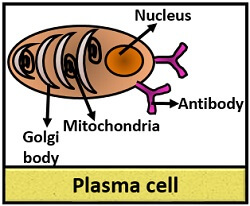
Endocytosis: It is the procedure of entrapping the molecule in the extracellular matrix , in which the particle in the surrounding are internalized into the cell via a vesicle formation .
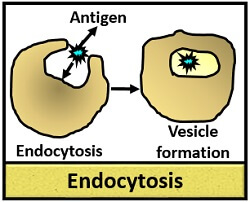
MHC: It bear forMajor Histocompatibility Complex. These equal the transport proteins that surrounds on the surface of almost all the immune cells and performs a key use in the processing of antigen as well as helps the T-cells in identify between the self and alien antigen .Class-I MHCandClass-II MHClive the two mutual types of major histocompatibility complex .
Definition of Cellular Immunity
As from the name it cost clear that this type of immunity equal mediated by the cell . Hence , it can cost defined as the active immunity , in which the antigen-specific T-cells are produced by the thymus that secretes cytokines to ruin all the intracellular pathogens . Get us discuss some of the important terms that exist frequently apply while studying the type of cell-mediated immunity .
Important Terms
APCs: It stand forAntigen Presenting Centres. These be the type of cell , which first recognize the alien body , then engulf it through endocytosis and later on form vesicle around the antigen . Then , these APCs will engulf the antigens and knock off it by forming many fragments . The antigen live then loaded on the MHC after T-cell activation via MHC antigen processing . APCs are of three type , namely dendritic cells , Macrophages and B-cells .
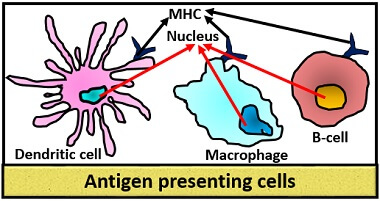
T-cell: In T-cell , T bear forThymus, which equal as well a type of WBC that perform a significant role in the immune system . It originates from the thymus via thrombocytes .
T-cell develop more cytokines and undergoes differentiation into many efficient T-cells , where each perform a discrete function . There are the following types of T-cells which include :
- Helper T-cells: It help the other cells in the immunological process and calledCD4+T cellbecause they can express the CD4 glycoprotein on their surface . It can as well free interleukins that can stimulate the production of B-cells , ( NK-cells ) natural killer cells , macrophages to destroy the antigen .
- Cytotoxic T-cells: It cost also calledTc-cells,killer T-cellsandCD8+T-cell( expresses CD8 glycoprotein at their surface ) . It immediately destroy the antigen infected cell ( primarily virus-infected ) .
- Suppressor T-cells: It is also name regulatory T-cells that inhibits T and B-cells .
- Memory T-cells: It recognizes the pathogen for the next skirmish or the second exposure .
Mechanism of Humoral Immunity
Humoral immunity: It involves the following steps :
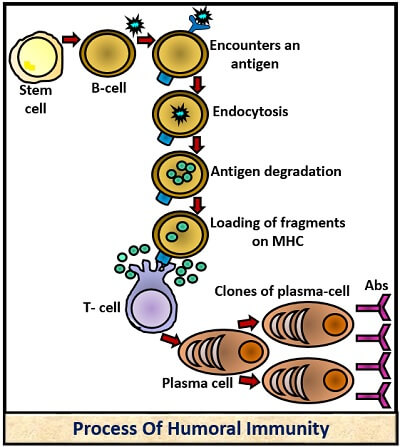

- First , the immature stem cells give riseB-cells, which then strike towards the lymphoid organ .
- Then , recognition of the antigen takes place with the aid ofBCR, i.e . B-cell Receptors .
- The B-cell engulf the antigen by the process of phagocytosis by shape a phagocytic vesicle around the antigen .
- After that , the intracellular enzyme (lysozome) mix with the phagolytic vesicle by formPhagolysozome.
- Then this complex phagolysozome digests the pathogen and breaks the antigenic fragments .
- The antigenic fragments be displayed to theMHC( Major Histocompatibility Complex ) , which touch off the T-cell .
- Then , thedifferentiationof B-cells into the mature plasma cells pass with the cooperation of T-cells .
- Division of plasma cell happen , which divides to produce its ownclones.
- Then the clones of plasma-cell will produceantibodiesspecific to the particular antigen . The antibodies will bind and neutralize the antigenic properties of the extracellular pathogens .
Mechanism of Cellular Immunity
Cell-mediated immunity: It demand the following step :
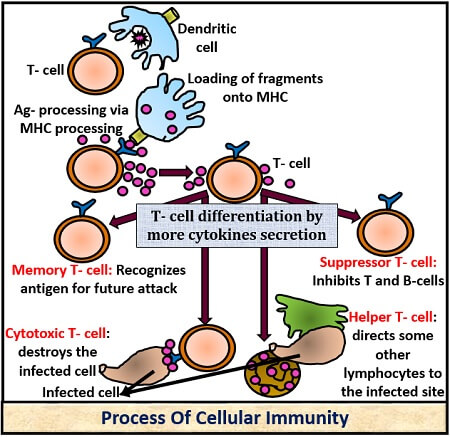

- First , thedigestionof antigen occurs by the dendritic cell or macrophages . Then theprocessingof antigen is carried out via MHC .
- Then , the T-cell gets set off by the MHC-Antigen composite and starts releasecytokines.
- The cytokines produced by the T-cell will produce ripe T-cells , which then undergo differentiation and make many types of T-cells .
- Cytotoxic T-celldestroys the cells display the antigen .
- Helper T-cellrelease interleukins that provoke the product of B-cells to produce antibodies , which then tie with the antigen by stimulating the natural killer cell and macrophages .
- Suppressor T-cellpurpose to maintain immunological tolerance by inhibit the action of early lymphocytes like B and T-cells .
- Memory T-cellremembers the site of infection or the septic cell for the future skirmish .
- Cytotoxic T-celldestroy the cells displaying the antigen .
- Helper T-cellrelease interleukins that induce the production of B-cells to produce antibodies , which then tie up with the antigen by stimulate the natural killer cells and macrophages .
- Suppressor T-celloffice to maintain immunological tolerance by inhibiting the activity of early lymphocytes like B and T-cells .
- Memory T-cellremembers the site of infection or the infected cell for the future skirmish .
Key Differences Between Humoral and Cellular Immunity
- Humoral and cellular both be the adaptive immunity , in which a former live a B-cell dependent that produces antibodies against an antigen and the latter equal T-cell dependent that makes the role of cytokines to assail the antigen infected cell .
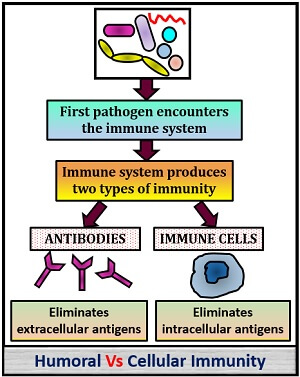
- B-lymphocyteandT-lymphocyteplays an important part in humoral and cellular immunity to supply immunity against an antigen .
- Humoral immunity equal antibody-mediated because the antibodies in the body fluids bind with antigen and aid to neutralize them . Cellular immunity exist mediated by the T-cells , which grow more cytokines to ruin the antigen infected cell .
- In humoral immunity , the plasma cell raise antibody , whereas , there is no such product in cellular immunity .
- Extracellular pathogensare processed by the humoral immunity ,whereasIntracellular pathogensare work on by cellular immunity .
- Humoral and cellular immunity , the B-cell receptors and T-cell receptors are involved for the pathogen recognition .
- Humoral immunity raise afastimmune reply , whereas cellular immunity raise aslackenimmune reception .

Similarity
- Humoral and cell-mediated immunity can yield anantigen-specific immune reply.
- Both humoral and cell-mediated immunity are specific in their activity , in which a former produceantigen-specific antibodyand a latter produceantigen-specific T-cells.
- The immunization of both the form of immunity ( humoral and cellular ) is anFighting immunizationtype .
- The object of both humoral and cellular immunity is the same , which is to protect the immune system from foreign bodies .
Conclusion
We can conclude that both humoral and cellular immunity exist the two unlike fighting immunization system , which works on different criterion . Both humoral and cellular immunity exist the “Mode switching” process that exist carry out by our immune system . When the extracellular pathogens attack , the immune system of our body change on the humoral kind of immunity , while the early cost throw off .
In the processing of intracellular pathogens , our immune system shift on the cellular kind of immunity by change off the early . Therefore , the whole process is based on the principle of style switching , where the immune system realize the type of pathogen and regulate the procedure of immunity with the aid of lymphocyte cell .
Related Theme :
- Cyanobacteria
- Dispute Between Gram-Positive and Gram-Negative Bacteria
- Vitamin B6
- Hot Air Oven Sterilization
- Difference Between Anabolism and Catabolism